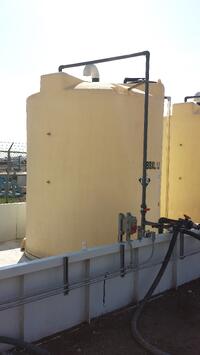Poly Processing Innovative Solutions Series: The Tangible Difference Between HDPE and Cross-Linked Polyethylene Storage Tanks
This is the first article in Poly Processing’s Innovative Solutions Series, where you’ll discover the many innovations that we have introduced to the chemical storage industry.
.jpg?width=776&height=407&name=Poly-Processing-Innovation-Series_The-Tangible-Difference-Between-HDPE-and-XLPE-Storage-Tanks%20(1).jpg)
Not all high-density polyethylene tanks are created equal. Although they sound nearly identical, high density polyethylene (HDPE) and cross-linked polyethylene (XLPE) chemical storage tanks have significant differences. Those differences could impact your organization’s bottom line, your people’s safety, and the operations of your facility.
Both HDPE and XLPE tanks are made with heated resins to create a cured plastic. However, the differences in their production create very different polyethylenes with very different structural strength. Let’s take a look at the manufacturing methods and see how XLPE is significantly different from HDPE.
Manufacturing HDPE Tanks
HDPE is created when thermoplastic resin is heated to create a fluid plastic that will harden and cure into a linear, high-density polyethylene surface. The molecules are connected like a rope—the individual threads of fiber are twisted together, but not tied.
HDPE tanks in general are cheaper due to the material costs and molding parameters. For certain applications, such as water storage, these tanks can do the job nicely.
Manufacturing Cross-Linked Polyethylene
Crosslinking is simply the formation of bonds between the polymer chains. These bonds, equal in strength and stability to the principal bonds along the polymer backbone, tie the polymers together, thus dramatically increasing molecular weight. In fact, the length of the polymer chains and, therefore, the physical properties, are much better than can ever be achieved without crosslinking.
The result is a plastic that possesses impact resistance, tensile strength, and resistance to fracture that linear polyethylene just can’t match. These qualities make cross-linked polyethylene an excellent choice when tank integrity is critical. The structural integrity, heat resistance, and greater useful life in most cases are unparalleled.
Strength and Durability: HDPE Vs. Cross-Linked Polyethylene
Both polyethylene resins are rotational molding-grade resins that have been ground into a powder to allow the material to melt easily during the molding process. Both resins are available in standard colors as well as some custom colors. Both resins are corrosion-resistant polyethylene.
However, the differences are critical. Compared to HDPE, XLPE provides:
- 10+ times the environmental stress crack resistance
- 10 times the molecular weight
- 3-5 times the impact and tensile strength
The four most important factors of HDPE tanks and XLPE tanks include:
- Environmental stress crack resistance/notch sensitivity
- Long-term hydrostatic strength
- Toughness and Durability
- Useful Life
In all four of these areas, factual testing and measurements show cross-linked resins are more durable than HDPE resins.
Small Differences Have a Tangible Impact
The implications of these differences are most obvious when testing the two plastics. When HDPE fails, it can fail catastrophically, because the HDPE polymer chains tend to “unzip.” In some cases, the entire tank comes undone, and a small leak becomes a chemical spill. All of the stored product could be lost, and the cleanup can be considerable.
.jpg?width=619&height=357&name=Linear%20Polyethylene%20Tank%20After%20First%20Drop%20(1).jpg)
On the other hand, XLPE might develop a small pinhole or tear, but the chances of a catastrophic failure is extremely low. You aren’t likely to lose all of your stored chemical if a leak develops, and the cost of cleanup and replacement in most cases is significantly less expensive. The risk to your employees and the environment can be drastically reduced, as well.
Poly Processing’s drop and pressure test videos offer an excellent demonstration of the structural differences between HDPE and cross-linked resins.
In most cases cross-linked polyethylene offers longer useful life in the same application as HDPE. As we stated earlier in this blog, they are both chemically inert materials. However, because XLPE has a significantly longer life and less financial impact in case of failure, the total useful life of cross-linked polyethylene is significantly better for your bottom line.
Learn more about engineering the right storage solution for your business—download our Comprehensive Tank Buying Guide.
- July 8, 2024
- Topics: Value Added, FAQs
About Poly Processing
Posts By Topic
Tech Talk Podcast Episodes
Subscribe By Email
Recent Posts
- Installation Tips for Chemical Storage Tanks: Site Preparation and Offloading
- Understanding pH and Chemical Concentration When Choosing a Chemical Tank
- Maximizing Fill Efficiency: Selecting the Optimal Fill Line System
- Chemical Storage Tanks: A Quick Guide for End Users
- Popular Customization Options for Chemical Storage Tanks
Tank Configurator

Find the recommended tank and system components for your chemical storage challenge.
Configure a Tank Package





